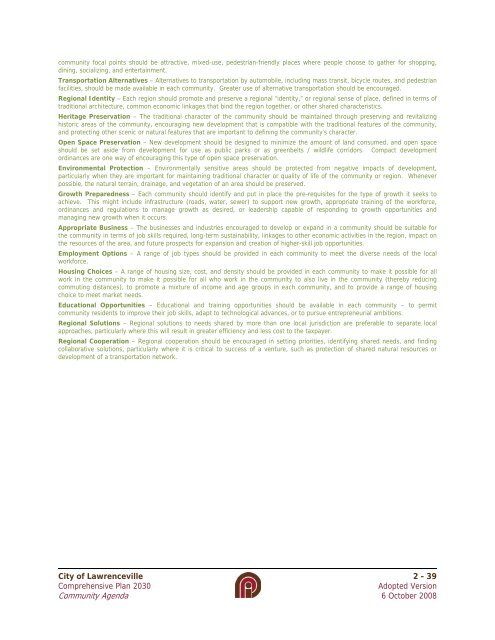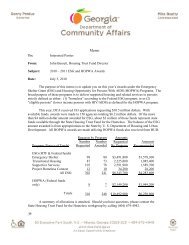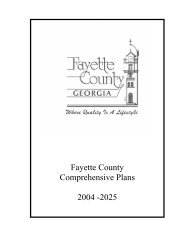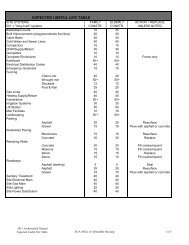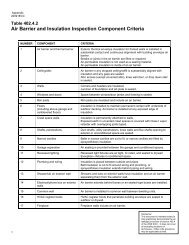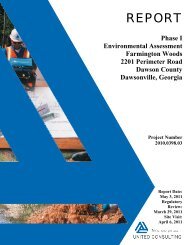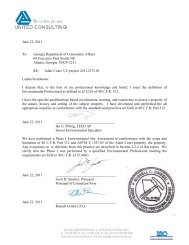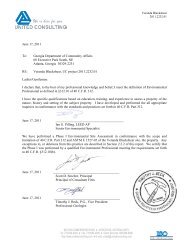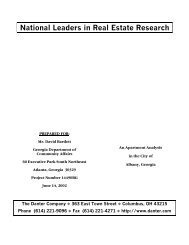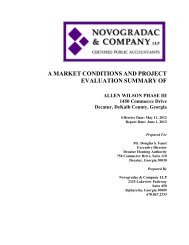City of Lawrenceville Comprehensive Plan Steering Committee
City of Lawrenceville Comprehensive Plan Steering Committee
City of Lawrenceville Comprehensive Plan Steering Committee
Create successful ePaper yourself
Turn your PDF publications into a flip-book with our unique Google optimized e-Paper software.
community focal points should be attractive, mixed-use, pedestrian-friendly places where people choose to gather for shopping,dining, socializing, and entertainment.Transportation Alternatives – Alternatives to transportation by automobile, including mass transit, bicycle routes, and pedestrianfacilities, should be made available in each community. Greater use <strong>of</strong> alternative transportation should be encouraged.Regional Identity – Each region should promote and preserve a regional “identity,” or regional sense <strong>of</strong> place, defined in terms <strong>of</strong>traditional architecture, common economic linkages that bind the region together, or other shared characteristics.Heritage Preservation – The traditional character <strong>of</strong> the community should be maintained through preserving and revitalizinghistoric areas <strong>of</strong> the community, encouraging new development that is compatible with the traditional features <strong>of</strong> the community,and protecting other scenic or natural features that are important to defining the community’s character.Open Space Preservation – New development should be designed to minimize the amount <strong>of</strong> land consumed, and open spaceshould be set aside from development for use as public parks or as greenbelts / wildlife corridors. Compact developmentordinances are one way <strong>of</strong> encouraging this type <strong>of</strong> open space preservation.Environmental Protection – Environmentally sensitive areas should be protected from negative impacts <strong>of</strong> development,particularly when they are important for maintaining traditional character or quality <strong>of</strong> life <strong>of</strong> the community or region. Wheneverpossible, the natural terrain, drainage, and vegetation <strong>of</strong> an area should be preserved.Growth Preparedness – Each community should identify and put in place the pre-requisites for the type <strong>of</strong> growth it seeks toachieve. This might include infrastructure (roads, water, sewer) to support new growth, appropriate training <strong>of</strong> the workforce,ordinances and regulations to manage growth as desired, or leadership capable <strong>of</strong> responding to growth opportunities andmanaging new growth when it occurs.Appropriate Business – The businesses and industries encouraged to develop or expand in a community should be suitable forthe community in terms <strong>of</strong> job skills required, long-term sustainability, linkages to other economic activities in the region, impact onthe resources <strong>of</strong> the area, and future prospects for expansion and creation <strong>of</strong> higher-skill job opportunities.Employment Options – A range <strong>of</strong> job types should be provided in each community to meet the diverse needs <strong>of</strong> the localworkforce.Housing Choices – A range <strong>of</strong> housing size, cost, and density should be provided in each community to make it possible for allwork in the community to make it possible for all who work in the community to also live in the community (thereby reducingcommuting distances), to promote a mixture <strong>of</strong> income and age groups in each community, and to provide a range <strong>of</strong> housingchoice to meet market needs.Educational Opportunities – Educational and training opportunities should be available in each community – to permitcommunity residents to improve their job skills, adapt to technological advances, or to pursue entrepreneurial ambitions.Regional Solutions – Regional solutions to needs shared by more than one local jurisdiction are preferable to separate localapproaches, particularly where this will result in greater efficiency and less cost to the taxpayer.Regional Cooperation – Regional cooperation should be encouraged in setting priorities, identifying shared needs, and findingcollaborative solutions, particularly where it is critical to success <strong>of</strong> a venture, such as protection <strong>of</strong> shared natural resources ordevelopment <strong>of</strong> a transportation network.<strong>City</strong> <strong>of</strong> <strong>Lawrenceville</strong> 2 - 39<strong>Comprehensive</strong> <strong>Plan</strong> 2030Adopted VersionCommunity Agenda 6 October 2008


